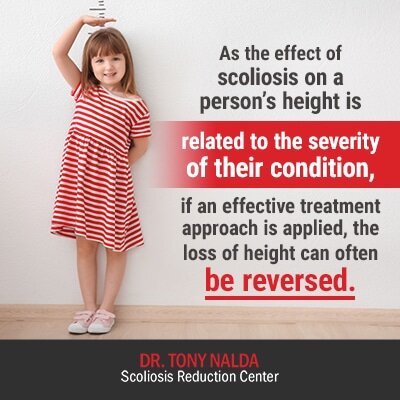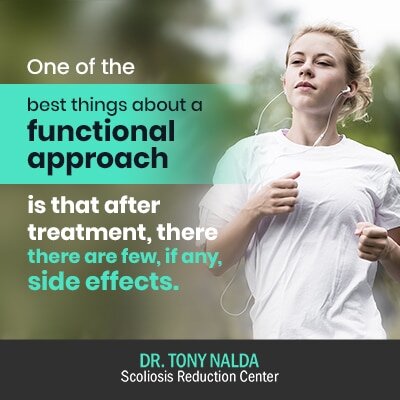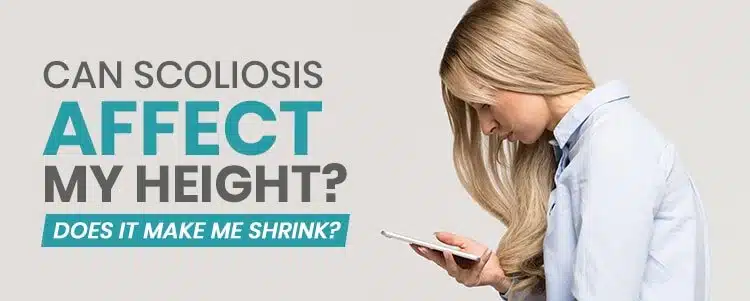Scoliosis can, indeed, affect a person’s height. As a person’s abnormal spinal curvature progresses, the related postural changes can range from subtle to overt. Depending on how severe your curvature is, how you respond to treatment, and your chosen treatment approach, some or all of that loss could be restored.
Scoliosis is a condition that can affect multiple areas of the body in unexpected ways. Let’s start by talking about the role of the spine’s healthy curves and how different degrees of scoliosis can impact a person’s height.
4 Key Takeaways
- Scoliosis and Height Impact: Scoliosis can affect a person’s height, particularly as the curvature progresses. A severe or rapidly worsening curvature can lead to noticeable height loss due to changes in the spine’s alignment and function.
- Functional Treatment Benefits: A functional, proactive treatment approach aims to correct the curvature on a structural level, potentially reversing scoliosis-related height loss. This integrative method combines chiropractic care, therapy, and bracing to reduce curvature and address symptoms.
- Traditional Treatment and Surgery: Traditional treatment methods may include spinal fusion surgery to prevent progression by straightening the spine. While this can restore some height, it comes with risks, including loss of flexibility and potential complications.
- Choosing the Right Treatment Path: The choice between functional and traditional treatment approaches significantly impacts outcomes related to scoliosis and height. Functional treatment offers a non-invasive, reversible option focused on curvature correction and symptom management.
Scoliosis and the Spine
People are often surprised to learn the many ways scoliosis can affect the body. Although it is a spinal deformity, its effects can be felt in far more areas than the spine alone.
The spine has three natural and healthy curves, and these curves give the spine its strength, flexibility, and allow us to maintain a straight and upright position. When one or more of the spine’s healthy curves are lost, the spine’s form and function can be thrown off balance.
With small curvatures, it’s unlikely that height will be affected, but as scoliosis is a progressive condition, meaning it’s in its nature to steadily worsen over time, that curvature will increase.
If a condition is progressing or is a severe form, scoliosis can result in a loss of height as the curvature means the spine is no longer straight and facilitating a perfectly-upright position.
The next important question to then ask is if it’s possible to reverse a scoliosis-related loss of height.
Scoliosis Treatment and Loss of Height

As the effect of scoliosis on a person’s height is related to the severity of their condition, if an effective treatment approach is applied, the loss of height can often be reversed.
While there are two main scoliosis-treatment approaches that can result in restoring a person’s height, they do so by different means and with different end goals in mind.
Depending on whether a person chooses functional or traditional treatment, the outcome can be very different.
How Functional Treatment can Restore a Scoliosis-Related Loss of Height
Here at the Scoliosis Reduction Center®, our approach is proactive and functional. We don’t want to just address symptoms of scoliosis, but the underlying condition itself. We do this by working towards a curvature reduction on a structural level.
Any scoliosis-related symptoms a patient is experiencing, such as a loss of height, will be addressed and treated alongside their abnormal spinal curvature.
As we successfully reduce a curvature, related symptoms such as postural issues, pain, and loss of height will be lessened/eliminated as the curvature is further reduced and the spine’s healthy curves are restored.
Here at the Center, we opt for an integrative approach that combines multiple treatment disciplines; this way, our patients benefit from the merits of each approach, and we can apportion them as the individual’s condition necessitates. We combine scoliosis-specific chiropractic adjustments, therapy, rehabilitation, and corrective bracing.

This customized approach allows us to respond to each patient’s condition and adjust our treatment plan based on how we see the spine responding. We also assess and document all experienced symptoms so we can gauge treatment success based not only on the degree of curvature reduction, but also on how related symptoms are impacted.
One of the best things about a functional approach is that after treatment, there are few, if any, side effects. Also, as our approach is natural and noninvasive, its effects are not irreversible. This means that if a person is unhappy with their treatment results, they can choose a different approach with no harm done; the same cannot be said of scoliosis surgery whose results are permanent.
How Traditional Treatment Restores a Scoliosis-Related Loss of Height
Those who have done research on scoliosis-treatment options would have come across the traditional approach and its use of scoliosis surgery to straighten a scoliotic spine. The procedure is known as ‘spinal fusion’, and it involves fusing the most-tilted vertebrae at the apex of the curvature together into one solid bone.
What this does is eliminate movement in the fused portion, thus preventing progression. A big difference between a functional and traditional approach using surgery is the end goal.
In functional treatment, the goal is to actually ‘correct’ the abnormal spinal curvature; with surgery delivered through the traditional approach, the end goal is to stop a condition from progressing.
The problem with the latter is that there is no guarantee surgery will permanently stop progression, but its results are permanent, whether a patient is happy with them or not. This is why I caution patients considering the invasive procedure to be very sure they have tried other less-invasive options first.
While spinal fusion can be successful in terms of straightening a crooked spine and restoring a loss of height along with it, it can come with some pretty big side effects and risk of complications.
As movement in the fused portion of the spine is eliminated, that comes with a loss of flexibility, and some patients are disappointed with the functional loss they experience post surgery.
The surgery itself is lengthy and invasive and carries multiple risk factors such as excessive bleeding, infection, pain at the site of fusion, nerve damage, hardware malfunction, and adverse reactions to the hardware used.
There are also the psychological effects of living with a fused spine. Many patients find this unexpectedly stressful as it changes their comfort level to do certain activities or try new things.
While the immediate surgical results might be the appearance of a straighter spine, if the surgery fails in some other form, or the patient is unhappy with the results, there is no reversing it, and the only response is to undergo more surgeries and face the risks again.
Conclusion
So if you have scoliosis and find yourself asking, can scoliosis make me shrink, the answer is yes, it can cause a loss of height. How much a condition impacts height will depend on just how severe the condition is and how effective treatment is.
Generally, the larger an abnormal curvature is, or the faster it is progressing, the more likely it is to cause noticeable symptoms such as pain, postural changes, and a loss of height.
If a condition is left untreated, it is virtually guaranteed to get worse, although there is no simple formula for predicting a patient’s rate of progression.
As a curvature progresses, or if the condition starts as a severe form, it is more likely to produce adverse symptoms, including a loss of height. The single best way to address this issue is the same as addressing other symptoms and scoliosis as a whole: by treating it proactively, effectively, and as noninvasively as possible.
Here at the Scoliosis Reduction Center®, we deliver treatment through a functional approach that has proven results, is noninvasive in nature, and will address a loss of height by impacting the underlying structural cause of it.





